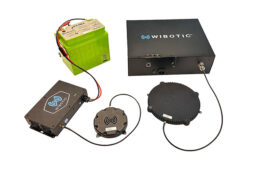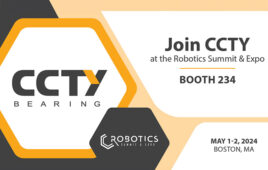Distribution centers shouldn’t just look for point solutions, notes Roger Counihan. The CRO Online Summit speaker gives a preview of how to pick a partner and sell robotics internally.

With the holiday rush upon warehouses, distribution centers, and retailers, now is a good time to review what business leaders must know as they bring robots into their operations.
As part of next week’s Chief Robotics Officer (CRO) Online Summit, Roger Counihan, vice president of sales at Fortna Inc., will discuss how to find an integration partner.
Fortna is a consulting and engineering firm that helps distribution centers with strategy, performance improvement, operations design and implementation, and warehouse management systems (WMS). Its clients include global brands in the automotive aftermarket, consumer goods, electronics, and third-party logistics spaces.
Counihan will also describe how to make a business case for change and how robotics champions can manage robotics in distribution centers.
He recently spoke with Robotics Business Review and provided a preview of his session.
Q: How did you become involved with robotics?
Counihan: Fortna has been a systems integrator in the distribution center space since the early 1990s.
Robotics has started to be a key piece that companies are looking at. It’s an important part of the evolution of distribution center technology.
Q: What types of robots are your customers looking at?
Counihan: We’re looking at a couple of key areas: AGVs [automated guided vehicles] and cobots, or picking and singulating robot arms.
There are some mature robotics as well, in terms of palletization and materials-handling equipment.
Emerging technologies such as machine learning, cobots, and end effectors are important for piece picking.
Many organizations are piloting robots in distribution centers, and Fortna helps provide a road map for distribution transformation.

Roger Counihan, vice president of sales at Fortna Inc.
Q: Is this a radical change, or a logical evolution for distribution centers?
Counihan: It’s a change that the industry is being forced into, following the example of major retailers like Amazon, Walmart, and Target. Their supply chain portfolio is forcing everyone else to figure out what they can do from a consumer-expectation perspective.
The e-commerce boom is creating more demand for warehouse labor than there is supply. Supply chains must reduce dependency on labor and improve customer service, and that means using software and robotics.
Q: What kinds of software do you mean?
Counihan: The software is moving from simple transactional databases. A key area for machine learning and AI is robotic control — identifying singulating products for picking and routing AGVs.
The next step is prioritization and work control, from releasing work as it comes into the building and seeing the next best piece of work to be done in the warehouse to sending it out to workforce or to other systems.
Q: What’s the role of simulation software?
Counihan: Fortna has multiple layers within its portfolio of services. We simulate the distribution center design to identify what bottlenecks can happen as orders flow through building, and where designs can fail.
Second is our actual machine control, execution software. It can perform simulations of changes to a design while it’s operating or to see what utilization or labor it will require in the coming day.
Simulation can identify where customers should automate, and we’ve found that transportation is often the starting point.
Q: Does introducing automation into distribution centers often involve process re-engineering?
Counihan: It’s not really as effective to take current manual processes and take each piece and point problem and look at automating it
Distribution centers need to look at the whole solution and identify where is the best place to use automation and where manual processes are still necessary.
They also must know what software is necessary from a WMS, ERP [enterprise resource planning], and order-management perspective and blend all those capabilities into an operations design.
Q: What have you seen in terms of the CRO or team and businesses’ preparation to engage with partners?
Counihan: We’re not seeing [the CRO title] too often, but we do see it in companies that are successful in their robotics initiatives — they do develop people who are dedicated to robotics.
You can’t adopt automation with ad hoc thinking, like it’s like all other technologies. Robotics is not mature enough, and many companies don’t have dedicated sales forces.
We have had conversations even before seeing that title. You need someone who’s going to be the lead in finding partners, finding what’s available, and who knows language of engineers.
Q: What do you mean by “hard” and “soft” business-case “levers” in selling robotics to management?

CROs in distribution centers need to know their processes and metrics. Source: Fortna
Counihan: “Hard levers” are classic business drivers — labor savings, capacity increases, and speed. Along with unit costs, quality of service, and storage savings, these are directly measurable and meet board expectations.
“Soft levers” are things that are more investments into the future. They include creating organizational awareness, new capabilities around robotics, and flexibility. For instance, it can be starting to build an infrastructure for pilots and research.
Q: How can a business shift its culture to successfully engage robots?
Counihan: Successful retailers in this space are the ones that see these soft drivers as important.
Walmart and Amazon are investing in robotics. They may not be making big labor savings, but they’re recognizing that it’s enabling them to have different capabilities in the future.
They already have fairly advanced AS/RS [automated storage and retrieval systems] and shuttle systems. That’s top-of-line unit sortation, but the recognize their limitations, so they’re developing these capabilities with more robots.
Q: What are some of the tradeoffs in expense models when building a business case for robotics?
Counihan: One example is the tradeoff between capital and operational expenses. There are different models between buying everything upfront versus the software as a service [SaaS] model for the long term.
In a high-throughput business, paying on a per-piece basis doesn’t make sense. It’s more willing to spend upfront and spread it out.
If you’re a newer e-commerce business experiencing high growth — for these types of companies, it may make more sense to have a robotics as a service [RaaS] or leasing model.
Q: What should customers look for in RaaS providers?
Counihan: For robotics hardware and software as a service models, there is just as much maturity as in other parts of this space.
It’s important to have a partner who’s invested in the success of the business, which must first know that a project is critical, not a “nice to have” or a freebie. Automation projects should not be for good publicity.
Q: How do you measure whether a project is successful?
Counihan: You’re often not looking at financial returns on initial metrics. Instead, you’re looking at operational returns from pilots.
For example, you could reduce labor in one process by 30%. Then you’d look at how to adjust operations everywhere to get that kind of results.
Q: Speaking of results, what are realistic return on investment (ROI) figures?
Counihan: As excited as everyone is about robotics in distribution centers, the metrics are often completely unrealistic.
CROs must be able to answer the question, “Would this project still be interesting without 30% ROI in a given timeframe?”
While robotics providers have a strong technical and developer side, they often don’t have people experienced in operations. As a result, there can be a lack of understanding of different areas of change within distribution centers.
Q: What should distribution centers look for in business partners?
Counihan: It’s fair game to ask integrators for examples of work they’ve done.
Other things to look at include “What are principles of how the company uses design for success, and are they in line with what I’m looking for?”
For example, you may want soft benefits from engaging in robotics projects, but for my project, risk is important. You then need enterprise-level support and a failover or backup solution.
Putting your company through technology that’s not enterprise-ready causes too much risk.
I believe in data-driven design. While robots are point-level solutions, you need an integrator who understands your operation and how to push forward.
Q: Are bigger or more established integrators better?
Counihan: You need a partner that you know is going to be there and be accountable for the work it has done.
You should also look for a breadth of capabilities across a wide variety of solution. The value of an integrator is having a partner that you can come to, across all the distribution challenges, without having to engage 10 or 15 different vendors.
Q: Some large robotics vendors offer integration support. How does that compare with integrators?
Counihan: It’s more about the client and whether it has the right capabilities in-house. If you have such an ability, you can engage vendors directly.

If a CRO has built out a robotics organization, then it may make sense for these companies.
The right model for the client is having a partner with the same motivations. A big part of Fortna’s efforts is working with vendors, helping them come to market. They don’t have a sales force and don’t know how to approach companies.
Robotics businesses may have good solutions, but Fortna knows enterprise-level support and provides 24/7 online support.
Editor’s Note: The CRO Online Summit will be on Wednesday, Dec. 5, 2018. Register now!




